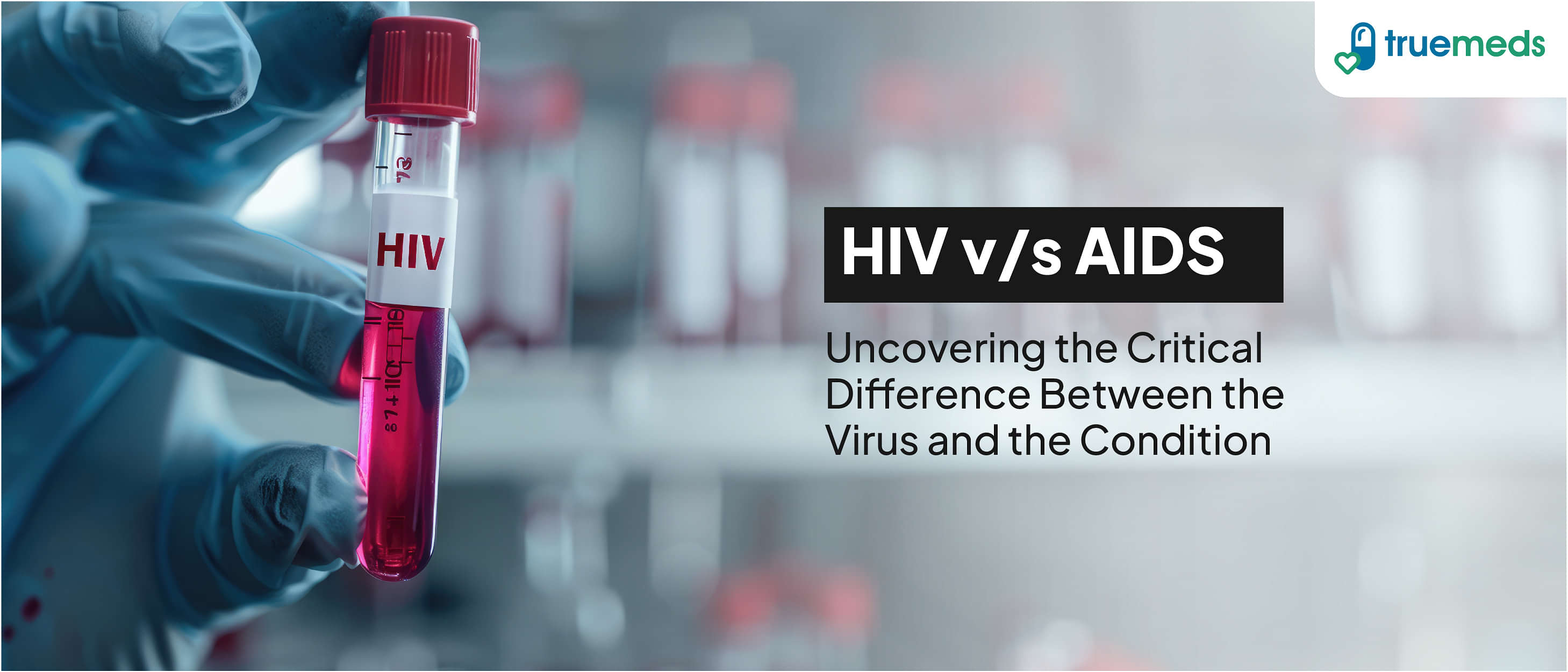Understanding the Difference Between HIV and AIDS
Last updated on : 13 Nov, 2024
Read time : 9 min
Understanding the difference between HIV and AIDS is essential for comprehending the progression and impact of these related yet distinct health conditions. HIV and AIDS have unique characteristics that affect the body differently. This blog aims to clarify the key differences between HIV and AIDS, helping you understand the virus, its effects, and the importance of timely treatment. Let’s start by exploring what HIV is and how it affects the body.
What is HIV?
HIV, or human immunodeficiency virus, is a virus that targets the body’s immune system, specifically attacking CD4 cells (also known as T cells or helper T cells). These cells play a crucial role in fighting off infections. When HIV infects and destroys these cells, it weakens the immune system, making the body more vulnerable to other infections and diseases. It can be spread through unprotected sex, sharing needles, or from mother to child during pregnancy, birth, or breastfeeding. As HIV progresses, it can lead to the development of AIDS.
What Is AIDS?
AIDS, or acquired immunodeficiency syndrome, is the advanced stage of HIV infection that occurs when the virus has severely damaged the immune system. This damage leads to a significant decline in the number of CD4 cells, typically below 200 cells per cubic millimetre of blood, or the development of one or more opportunistic infections. The weakened immune system cannot effectively fight off these infections. Without antiretroviral therapy, individuals with AIDS have a significantly reduced life expectancy. However, timely treatment can prevent the progression from HIV to AIDS and improve the quality of life for those affected.
What’s the Difference Between HIV and AIDS?
HIV and AIDS are often used interchangeably, but they are not the same thing. HIV is a virus that attacks the immune system by targeting and destroying CD4 cells, which are crucial for fighting off infections. If left untreated, HIV can lead to the development of AIDS, which is the late stage of HIV infection. AIDS is characterised by severe damage to the immune system, with a significant decline in CD4 cells and the presence of opportunistic infections or cancers. Understanding the causes of HIV and AIDS is important for prevention and management of the condition.
What Causes HIV/AIDS?
HIV is caused by the human immunodeficiency virus, which is transmitted through the exchange of bodily fluids such as:
- Semen
- Vaginal fluids
- Anal mucus
- Blood
- Breast milk
Common modes of transmission include unprotected sex, sharing injection drug equipment, and mother-to-child transmission during pregnancy, birth, or breastfeeding.
AIDS, on the other hand, develops when HIV has severely damaged the immune system, typically after many years of untreated HIV infection. This damage is indicated by a low CD4 cell count or the presence of opportunistic infections and cancers that the weakened immune system cannot combat.
What are the symptoms of HIV & AIDS?
HIV and AIDS symptoms are distinct and progressive. Early HIV symptoms can be mild and flu-like, while AIDS symptoms are more severe and related to opportunistic infections.
Early HIV symptoms
Early HIV symptoms often appear 2-4 weeks after infection and can include fever, headaches, fatigue, swollen lymph nodes, skin rash, muscle aches, joint pain, sore throat, painful mouth sores, diarrhoea, weight loss, cough, and night sweats. These symptoms can be mistaken for another viral illness and may not always be present. As HIV progresses, the symptoms can become more severe and indicative of AIDS.
Later HIV/AIDS symptoms
As HIV progresses but before it reaches the AIDS stage, some individuals may experience a period of latency with minimal or no symptoms. However, without treatment, the virus continues to damage the immune system. AIDS is characterised by severe immune system damage, leading to opportunistic infections and cancers. Common symptoms include:
- Thrush (candidiasis)
- Cytomegalovirus (CMV)
- Herpes simplex virus (HSV)
- Malaria
- Pneumocystis pneumonia (PCP)
- Toxoplasmosis (Toxo)
- Tuberculosis (TB)
Where Can I Go for HIV Testing?
If you think you might have been exposed to HIV or are experiencing symptoms, it’s important to get tested as soon as possible. In India, HIV testing can be accessed at various government hospitals, clinics, and private healthcare facilities. You can visit your GP or a sexual health clinic, where they offer confidential HIV testing services. Many clinics also provide free or low-cost tests. National AIDS Control Organization (NACO operates many ICTCs (Integrated Counseling and Testing Centres), which can be found in government hospitals, medical colleges, district hospitals, and even mobile clinics in rural areas. You can visit NACO’s website for a list of ICTCs and hospitals in your region, or contact private labs for an appointment. You can also approach NGOs that provide confidential HIV testing services.
What’s the Treatment for HIV?
The primary treatment for HIV is antiretroviral therapy (ART), which involves taking a combination of medications to suppress the virus and prevent it from progressing to AIDS. ART helps to:
- Reduce the viral load in the body
- Improve the functioning of the immune system
- Decrease the risk of transmitting HIV to others
Adherence to the prescribed medication regimen is crucial for the success of the treatment. Missed doses can lead to drug resistance and reduced effectiveness of the therapy. Regular follow-up with your doctor is necessary to monitor your viral load, CD4 cell count, and overall health.
How Can I Prevent HIV?
Preventing HIV involves a combination of strategies, including practicing safe sex, avoiding sharing needles, and getting tested regularly. Using condoms or other barrier methods during sexual activities can significantly reduce the risk of transmission. For individuals at high risk of HIV, pre-exposure prophylaxis (PrEP) is an effective preventive measure, while post-exposure prophylaxis (PEP) can be taken within 72 hours after potential exposure. Pregnant women with HIV can reduce the risk of transmitting the virus to their child by adhering to ART during pregnancy, delivery, and breastfeeding. By adopting these preventive measures, individuals can greatly reduce their risk of contracting HIV and help prevent its spread to others.
Living with HIV and AIDS
For those living with HIV and AIDS, careful management and adherence to treatment are essential for maintaining health and quality of life.
Antiretroviral therapy plays a crucial role in reducing the viral load, making the virus undetectable and preventing the progression to AIDS. Adhering to the prescribed ART regimen is vital for its effectiveness. Regular medical check-ups, including monitoring of CD4 cell counts and viral loads, help healthcare providers adjust treatment plans as necessary. In addition to medical management, individuals living with HIV and AIDS can benefit from:
- Maintaining a healthy lifestyle through a balanced diet and regular exercise
- Avoiding substances like alcohol and tobacco that can weaken the immune system
- Seeking mental health support to cope with the psychological impacts of the condition
- Joining support groups to connect with others facing similar challenges
By adopting a comprehensive approach to managing HIV and AIDS, individuals can lead long and fulfilling lives while minimising the risk of transmission to others.
Conclusion
Understanding the difference between HIV and AIDS is vital for effective prevention, management, and treatment of the condition. While HIV is a virus that attacks the immune system, AIDS is the late-stage condition resulting from untreated HIV infection. Thanks to advancements in antiretroviral therapy, people living with HIV can now lead long and healthy lives without progressing to AIDS, provided they adhere to their prescribed treatment regimen. Preventive measures such as practising safe sex, avoiding shared needles, and regular testing are crucial in controlling the spread of HIV. By promoting education and awareness about HIV and AIDS, we can work towards reducing the stigma surrounding the condition and empowering individuals to take proactive steps in protecting their health and the health of others.
Frequently Asked Questions (FAQ)
With proper antiretroviral therapy (ART), people living with HIV can have a near-normal life expectancy, with only an 8–13 year difference compared to those without HIV.
People engaging in unprotected sex, particularly men who have sex with men, injection drug users, and those with multiple sexual partners, are at the highest risk for HIV.
HIV is believed to have originated from the zoonotic transmission of simian immunodeficiency virus (SIV) from chimpanzees to humans, likely through hunting and handling of infected animals in Central Africa.
Yes, HIV can be transmitted from a woman to a man through unprotected vaginal or anal sex, as well as through mother-to-child transmission during pregnancy, childbirth, or breastfeeding.
Yes, when used correctly and consistently, condoms can significantly reduce the risk of HIV transmission during sexual activity, making them an essential tool in HIV prevention.
ART helps manage HIV by suppressing the virus, increasing CD4 cell counts, and preventing the progression to AIDS, thereby reducing the risk of transmitting HIV to others.
References
Disclaimer
Our healthcare experts have carefully reviewed and compiled the information presented here to ensure accuracy and trustworthiness. It is important to note that this information serves as a general overview of the topic and is for informational purposes only. It is not intended to diagnose, prevent, or cure any health problem. This page does not establish a doctor-patient relationship, nor does it replace the advice or consultation of a registered medical practitioner. We recommend seeking guidance from your registered medical practitioner for any questions or concerns regarding your medical condition.
Popular Articles
Recommended Articles
Recent Articles
Top-Selling Medicines:
...View more
Top-Selling OTC:
...View more
Company
About UsHealth ArticleHealth StoriesDiseases & Health ConditionsAll MedicinesAll BrandsNeed HelpFAQSubscribe
Registered Office Address
Grievance Officer
Download Truemeds

Contact Us
Our customer representative team is available 7 days a week from 9 am - 9 pm.
v3.7.10
Our Payment Partners



























































